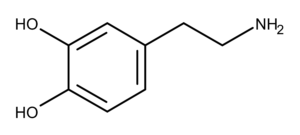The Chemistry of Dopamine
Dopamine is a monoamine neurotransmitter in the catecholamine family of compounds.1 It is produced from the amino acid tyrosine, and it is a precursor or epinephrine (adrenaline) and norepinephrine. Dopamine was first synthesized in 1910 by Barger and Hill.2
The Pharmacology of Dopamine
In 1957, Montagu was the first to discover dopamine in the brains of various animals.3 In the same year, the Nobel Prize-winning scientist Arvid Carlsson first recognized dopamine’s function as a neurotransmitter in the brain.4 In 1958, Carlsson and Waldeck developed a method for measuring the amount of dopamine in brain tissues.5
In humans, there are five receptors that mediate virtually all the effects of dopamine.1 These receptors belong to the G protein-coupled receptor family and are designated D1, D2, D3, D4, and D5. Studies have indicated that D1, D2, and D3, among other things, mediate locomotor activity in the body.6,7 The physiological roles of D4 and D5 are less clear. In a 2011 review article, Beaulieu and Gainetdinov say in summary: “In general, the specific physiological roles played by D3, D4, and D5 dopamine receptors in the brain remain largely unknown.” 8
The dopamine pathways in the central nervous system are critical for many physiological functions. Among them are voluntary movement, feeding, affect, reward, sleep, attention, working memory, and learning.8 In the peripheral nervous system, dopamine has roles in olfaction, hormone regulation, retinal processes, cardiovascular function, sympathetic nervous system regulation, immunity, and renal function.
Dopamine’s involvement in so many bodily functions implicates it in several diseases and disorders. These include Parkinson’s disease, depression, schizophrenia, bipolar disorder, hypertension, pituitary tumors, nausea, and erectile dysfunction.1
The Applications and Potential of Dopamine
The hydrochloride salt of dopamine is indicated for a variety of cardiac conditions such as congestive heart failure and after cardiopulmonary resuscitation or cardiac arrest. Dopamine helps treat the hemodynamic instabilities resulting from these conditions, such as circulatory collapse and shock.
Therapies for symptoms of Parkinson’s disease include administration of dopamine agonists and drugs that block dopamine metabolism.9
In 2007, researchers studying the adhesive proteins in mussels discovered that dopamine could self-polymerize and create a thin film on surfaces.10 The researchers named the coating material polydopamine. Further experiments revealed that polydopamine could create a thin film on a variety of organic and inorganic surfaces, including polymers, semiconductors, ceramics, and noble metals. Polydopamine films can be modified using nanoparticles for use in drug delivery, interfacing with cells, and in creating biosensors.11,12
